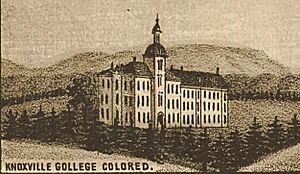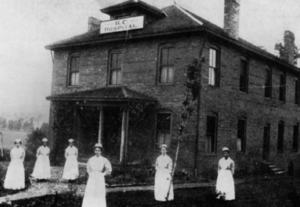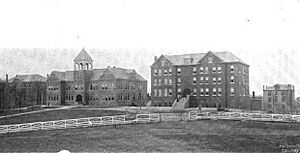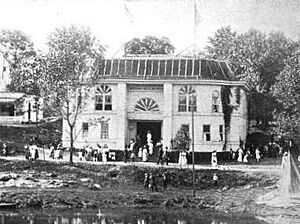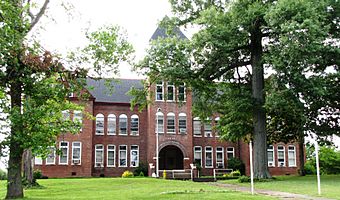Knoxville College facts for kids
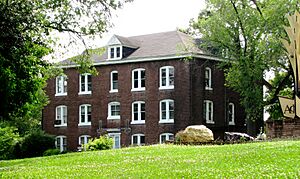 |
|
| Motto | Let There Be Light |
|---|---|
| Type | Private historically black college |
| Established | December 16, 1875 |
| Affiliation | Presbyterian Church (U.S.A.) |
| Endowment | $1 million (appx.) |
| Chairman | Dr. Eric Barnes |
| President | Dr. Rotesha Harris |
|
Academic staff
|
35 |
| Students | 11 |
| Location |
,
Tennessee
,
United States
35°58′12″N 83°56′45″W / 35.97000°N 83.94583°W |
| Campus | Urban, 39 acres (16 ha) |
| Colors | Garnet and blue |
| Nickname | Bulldogs |
Knoxville College is a private college in Knoxville, Tennessee, USA. It is a historically black college, meaning it was founded to educate African American students. The United Presbyterian Church of North America started the college in 1875.
The college faced challenges starting in the 1970s. By 2015, it had only 11 students. Classes were paused for a time to help the college reorganize. In May 2018, the state allowed Knoxville College to offer classes again. The college began enrolling students for the fall 2018 semester. In May 2022, three students successfully graduated.
Contents
History of Knoxville College
How the College Started
Knoxville College began as a special school in Knoxville in 1864. It was started by R. J. Creswell of the United Presbyterian Church. The school's goal was to educate Black people who were free or had been freed from slavery.
The school first met in the First Baptist Church. Later, in 1866, it moved to its own building. Even though some city leaders were not supportive and some white people made threats, more than 100 students joined. White students also attended until 1901, when Tennessee passed a law forcing all schools to be separated by race.
In the 1870s, the church decided to build a bigger school in Knoxville. In 1875, they bought the land where the college is now. This land was a hill that had been a Confederate army spot during the Civil War. The first building, McKee Hall, was finished in 1876, and the school opened in December of that year.
John Schouller McCulloch was the first principal. The school mainly trained teachers, but it also had a school for local children. In 1877, the state officially called it a college. In 1890, the state gave the college money to start departments for mechanical skills and agriculture.
Medical Department (1895–1900)
Before 1865, there were no medical schools for African Americans. Knoxville College had an early medical department for Black students from 1895 to 1900. This department was created with help from the "Colored Department" at the University of Tennessee. William Wallace Derrick, an African American faculty member, helped set it up. The Knoxville College Hospital opened in 1907.
After this department closed, the city of Knoxville started a new medical school for Black students in 1900. It was called the Knoxville Medical College.
Growth in the Early 1900s
In 1901, Knoxville College officially received its charter from the State of Tennessee. A few years later, in 1907, the school opened the Eliza B. Wallace Hospital. This hospital trained nurses and helped the health of the local Black community. It was very important during the city's Influenza outbreak in 1918.
In 1913, John Henry Michael, who led the school's mechanical department, designed a building for a big exhibition. This building was constructed with the help of Knoxville College students.
During World War I, Knoxville College students helped raise money for war bonds and the Red Cross. After a difficult racial event in Knoxville in 1919, the school's leaders supported the African American community. In 1925, students protested the school's strict rules. They held a month-long boycott of classes. This led to some rules being changed and the creation of a student council.
In 1957, Knoxville College became one of the first historically Black colleges to join the Southern Association of Colleges and Schools (SACS). In the summer of 1960, Knoxville College students held sit-ins to protest segregation at lunch counters downtown. Their actions helped end this practice in many businesses. In 1962, the school's rules were changed to allow white students to attend.
Challenges and Rebuilding Efforts
Starting in the 1970s, Knoxville College began to face money problems. In 1997, the Southern Association of Colleges and Schools removed the college's accreditation. This meant the school was no longer officially recognized, and student numbers dropped a lot. The college struggled to pay its staff and bills. Many buildings were closed and left empty.
In 2006 and 2007, former students worked hard to raise money to save the college. In 2010, Horace A. Judson became the interim president. He created a plan to help the college get back its accreditation, become financially stable, and improve its programs.
However, the college continued to struggle. In 2014, the Environmental Protection Agency had to clean up dangerous chemicals that the college had stored improperly. In 2015, the college paused classes to reorganize. Student numbers were very low, and the college had large debts.
By 2016, many campus buildings were in bad shape. The city of Knoxville asked the college to fix them or they would be closed. Firefighters responded to many fires in the abandoned buildings.
As of August 2018, most of the campus was still empty and damaged. However, the college's main offices moved back to campus. There were plans to fix McMillan Chapel and the Alumni Library.
In 2023, Knoxville College's Vice President Dasha Lundy worked with other schools to help the college regain its accreditation. This is the college's main goal now. In August 2024, the college applied for accreditation with the Transnational Association of Christian Colleges and Schools.
Campus Life and Buildings
Knoxville College is on a 39-acre campus with 17 buildings. It is located on a hill near downtown Knoxville. The campus has administration and classroom buildings, a performing arts center, a gym, a library, a chapel, and a student center. There are also dorms for students and houses for faculty.
Historic Buildings on Campus
In 1980, eight buildings on the Knoxville College campus were recognized as important for minority education. They were added to the National Register of Historic Places. Many of the first buildings were built by students using bricks they made themselves.
The historic buildings include:
- McKee Hall: This is the oldest building, first built in 1876. It was largely rebuilt after a fire in 1895. It is named for O.S. McKee, who started the first school for African American children in Nashville. This building now holds administration offices.
- The President's House: Built in the late 1880s.
- Wallace Hall: Built in 1890 as an orphanage. It is named for Eliza B. Wallace, who was the principal for female students.
- Elnathan Hall: Built in 1898. It has been a women's dorm, an administration building, and a classroom building. It was destroyed by fire on November 4, 2024.
- Two Faculty cottages: Built in 1906.
- McMillan Chapel: Built in 1913, designed by a Knoxville College graduate, William Thomas Jones. It was used for church services and performances. Famous people like George Washington Carver and Jackie Robinson gave speeches here.
- Giffen Memorial Gymnasium: Built in 1929.
In 2016, a group called Knox Heritage listed the Knoxville College Historic District as one of the most endangered historic places in the Knoxville area.
Freedmen's Mission Historic Cemetery
The Freedmen's Mission Historic Cemetery is a historic burial ground for African Americans on the campus. It is located at the corner of Booker and College streets.
College Leadership
A group of 16 trustees leads Knoxville College. Dr. Eric Barnes is the chairman. The board includes people from the Knoxville College National Alumni Association. The board chooses the president, who is the main leader of the school.
On December 5, 2024, Dr. Rotesha Harris was announced as the college's 32nd President.
Academics and Learning
As of 2010, Knoxville College offered two types of degrees: a four-year Bachelor of Liberal Studies and a two-year Associate of Arts. The Bachelor's degree allowed students to focus on areas like Humanities, Business and Computer Sciences, Natural Sciences and Mathematics, or Social and Behavioral Sciences.
Knoxville College had a special program to help students avoid debt. This was called the College Work Program. Students could work several hours a week on campus, in the community, or through internships. This helped them pay for their tuition.
Student Life
The Student Government Association (SGA) was elected by the students. It helped students communicate with the college leaders. The SGA was led by a president.
Students could join many activities, including a dance team, a debate team, a choir, and a trivia team. The school's newspaper, The Aurora, was published for over 100 years. The college also had a student ambassador program and a wellness program that helped the local community.
After 1997, Knoxville College stopped most sports programs because fewer students were enrolled. However, as part of its reorganization, the college hopes to bring back men's and women's basketball teams and a cheerleading squad.
Notable Alumni
| Name | Class year | Notability | |
|---|---|---|---|
| William Coffee | Cryptographer | ||
| George E. Curry | Editor of the National Newspaper Publishers Association news service | ||
| Michael Eric Dyson | Attended, but transferred | Professor, author, and media commentator | |
| Lillie England Lovinggood | 1889? | Writer and teacher | |
| C. Virginia Fields | 1967 | Social worker and former Borough President of Manhattan, New York | |
| Johnny Ford | Mayor of Tuskegee, Alabama | ||
| Jake Gaither | 1927 | Florida A&M University football coach and member of College Football Hall of Fame | |
| Grady Jackson | 1997 | Former defensive tackle in the National Football League | |
| Vernon Jarrett | 1941 | First African-American columnist for the Chicago Tribune | |
| Ken Johnson | Former defensive end in the National Football League | ||
| Lyman T. Johnson | Educator and leader in racial desegregation in Kentucky | ||
| Edith Irby Jones | First female president of the National Medical Association | ||
| Mildred Kelly | 1949 | First Black woman to serve as a US Army sergeant major | |
| Willie E. May | 1968 | Director of the National Institute of Standards and Technology | |
| Ralph Wiley | Author, speaker, and sports columnist | ||
| Palmer Williams Jr. | Actor, known for Tyler Perry's House of Payne |
See also
- Mayers' Industrial School


